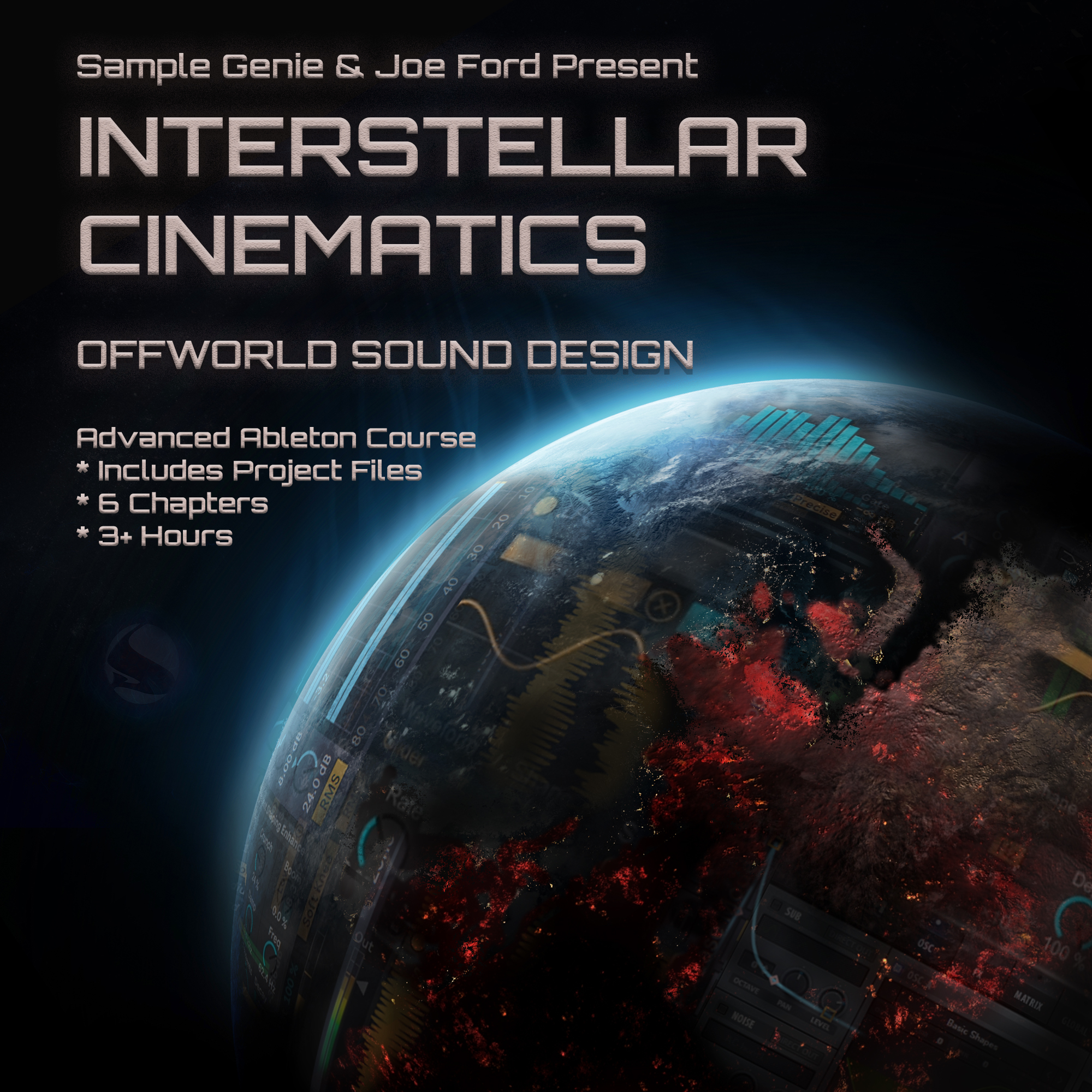Analysis of S5E02: Lenzman – Creative Approach
- This topic has 9 replies, 5 voices, and was last updated 6 years, 5 months ago by ,
Mircea.
-
AuthorPosts
-
-
2017-08-03 at 16:50:42 #28679,
 HarryModerator
HarryModeratorDAW used: Reason – easy to follow along in any other DAW
Lenzman’s first ever tutorial, as well as his first of two for Sample Genie this season. I would consider this more of a demonstration than a technical tutorial, and it is well worth watching. The idea behind this is just making a basic sketch, which you can do for any genre or sub-genre, it’s all in how you apply what Lenzman demonstrates.
He states that currently he prefers making a batch of sketches to get ideas down quickly, and that this reduces the pressure to write a whole track. He explains that one could write ten track sketches, taking about an hour each, where as if you focus on writing one song it could take approximately ten hours. Generate ten ideas, set them aside for a few weeks, then revist them, picking the best two or three sketches to work up to full tracks. He does not mention it, but those other sketches could be salvaged for pieces of future tracks, pulling out any good ideas or samples.
Notes for the sketch done in this track:
02:00 – first sample is a piano improv from another project
• He likes the hits & chords in the sample
• He sliced the sample in to individual hits using Recycle, then loads the slices (.rx2 files) in to a DRx Sampler in Reason
○ He does not show using Recycle, but many DAWs have a slice sample function now03:45 – adds a break sample, loops 32 bars, and then plays around with the piano samples over top
• Picks a chord he likes from the sample, and builds around that05:40 – works out a call & response with the piano sample hits
• Gets a 4-bar sequence that he loops, and will build upon further
• Cleans up the note placement with quantizing to the grid, and lengthens the notes using a legato tool. This tool forces the MIDI notes to expand until the next recorded note.08:45 – working on a piano turn-around
• Others might call this a fill or a switch, but basically mean the same thing
• These happen at the end of 8 bars11:30 – adding bass, using a bass sample loaded in to the NN-19 Sampler
• Wants the bass to be punchy, rather than a droney / reece-style bass13:30 – when writing basslines, he often pitches the bass up 1 or 2 octaves to hear if the notes fit in key, then drops down to the range it will actually be used at
• Root key for the bass in this example is D16:00 – adding another break to add more character & body
• Lenzman mentions the step of a break, basically this is the pattern of the main kick & snare
• The new break has the same step as the original break, he likes how they sound layered together
• At the end of this analysis I did two examples of this, info & links at the bottom.17:45 – adds another break to use as a fill at the end of the 16-bar loop
• This break is not layered with the others, it’s a quick switch, and then back to the layered breaks
• Didn’t pay close attention to the step / beat of the fill, but it is probably different from the other two breaks18:30 – color coding of the parts of the sketch, just for own organization preferences
19:00 – section starts on dubbing out the piano, making a duplicate track
19:30 – demonstration of using a notch peak sweep to find resonant frequencies in the piano sample
• Uses an EQ to notch out the frequencies he does not want21:00 – delay & reverb FX on the second piano track
22:50 – expanding further on the sketch ideas, making it a 32-bar loop
• Add automation of the piano loop’s sampler’s filter
• Begins previewing stabs and strings to add to the sketch26:30 – adding dubby percussion
• Likes using snares and adding a lot of reverb30:30 – reiterates the opinion is to sketch ideas and not spending time on technical mixing and arranging
• Sets sketches aside for a month, feels that listening to them after a break lets one have a detachment from the piece, and really figure out which ideas are worth continuing work onThoughts:
• I liked the reasoning behind sketching, been doing it myself the past two years. It’s not mentioned in the tutorial, but often in Lenzman’s social media, he has a young child. I’m in a similar family situation, and the time available for creative work is limited, so the reason for sketching makes sense when I might only have an hour a day to work on music. I find I have more fun with everything taking this approach, and I have finished more music when I build up the sketches that have more potential.
• Not much in the way of technical approaches, so the tutorial might not appeal to some people, however the demonstration is a good look at an artist’s process.
• I really like playing around with editing breaks and loops, and then layering them, so the part at 17:45 was interesting. I decided to knock up a couple examples of what was demonstrated, using breaks from this month’s sample pack:○ Halogenix – Two Step Example – August 2017 by R4NS0M
A quick demonstration of two drum loops with similar beats / steps, layering them, and then a second layer version with some sidechain EQ action from Trackspacer.
○ Lenzman – Other Step Example – August 2017 by R4NS0M
This example is a bit longer, and I’ll explain best I can. The two drum loops have slightly different beats / steps this time. The first drum loop is the Lenzman Pandora loop, which is a funkier version of the two step, where the second kick is a few beats earlier than the typical 2-step beat (check the Halogenix beats from this month). Skeptical and Alix Perez have been using this type of beat in some stuff lately, check “Solitude” for an idea.
The second drum loop is Lenzman’s Anderson loop, which is a standard two step beat with a ghost kick after the first kick, so it has a bit of double kick feel going on. If you layered the Pandora and Anderson loops as is, the kicks won’t line up, however what’s cool to me is you could get a bit of a polyrhythm going. It helps that all the snares would line up.
The next loop is the Pandora loop edited to have the same step as the Anderson loop. Following that is an example of the edited Pandora layered with Anderson, and then I did a version with Trackspacer sidechaining EQ on Pandora.
Next example in all this, the sixth loop, is the Anderson loop edited to match the original Pandora beat, so it’s that sort of funky 2-step. Following that is an example of the two beats layered, following Pandora’s beat structure, and then the final example is Trackspacer sidechain EQ on Pandora, making it a layer underneath Anderson.
—–
I wanted to get this one out near the start of the month, so I have the most recent videos analyzed, and then the other weeks of the month I get out the backlog I’m working through. Next week I’ll post about S1E02: State Of Mind – Workflow & Arrangements. Will be interesting, as they’re also taking part this season, so maybe we’ll see a change between SOM 2013 and SOM 2017?"Knowledge kept is knowledge lost." - Bobbito Garcia
-
2017-08-03 at 20:42:25 #28687,
Mircea
ParticipantAmazing job! Thank you for this. On a personal level I didn’t quite find the dubby percussion to suite the sketch he made, but that’s just me. All in all, I totally agree with the sketch approach, especially when your time is limited and you have to somehow get everything and everyone happy in the timeframe of one day.
-
2017-08-04 at 12:34:22 #28712,
 GENIE HQKeymaster
GENIE HQKeymasterTop Job on this write-up. Wow.
The ten sketch idea, leaving them to settle for a month is fresh approach. After month one obviously you’ll have both tracks to sketch and then tracks to finish on the go. Organisation is key here, easy to get in a tangle with what’s being worked on.
But this approach will work for any style that’s what we love about it.
Forcing you to move on and be creative rather than fixating on a snare frequency for too long.
Engaging the Right-brain as much as possible is the name of the game!Big up Ransom for the thorough work on this.
-
2017-08-04 at 16:01:30 #28733,
 HarryModerator
HarryModeratorThanks guys! The kicker is Lenzman is playing in my city next week (DC), but I’ll be 400 miles away on holiday. Would have told him in person I liked the demonstration.
As for sketches, the other thing is doing ten, you could do that in a week, over two weeks, and get a cycle where you have sketch sessions, sound design sessions, and full on writing or mixing sessions once you have material you want to build up.
Another artist I’ve seen mentioning this type of approach recently is Nominee/Outrage, although he talks more about building up a 16-bar loop, comparing it to a boiling pot.
"Knowledge kept is knowledge lost." - Bobbito Garcia
-
2017-10-17 at 21:01:31 #31320,
 VincentParticipant
VincentParticipantHi Harry,
Can you tell me where I can find the video of Lenzmann ?
Because I am a realy crazy fan of Lenzmann and I come here for Lenzmann tutorial, I heard about this video everywhere, but I do not find it ..
Thanks you Harry ! -
2017-10-18 at 01:48:12 #31325,
 HarryModerator
HarryModeratorIt was from this August’s Sample Genie material. If you weren’t subbed to the service that month, the videos eventually become available for purchase in the Video Vault, I think. Not sure how long between the original post and the archive availability.
"Knowledge kept is knowledge lost." - Bobbito Garcia
-
2017-10-18 at 08:20:56 #31328,
 VincentParticipant
VincentParticipantok, I understand, so it’s not certain that it happens, in any case tomorrow there is a Lenzmann tutorial that happens, but I think it’s another than August.
Thank you for your answer 😉
-
-
2017-08-06 at 17:58:25 #28784,
 JFCSUKParticipant
JFCSUKParticipantThought this was a great tutorial and interesting to see how Lenzman works – would be interested to know how he goes about finding his samples? There isn’t much reference to this.
Hope he does more tutorials in the future!
-
2017-08-09 at 13:05:45 #28846,
 HarryModerator
HarryModeratorI think The Genie mentioned on FB a Q&A with Lenzman possibly later this month. I know he’s on a North American tour right now, so maybe after that wraps up?
Also, working through my notes for the next analysis, intend to have it posted later today.
"Knowledge kept is knowledge lost." - Bobbito Garcia
-
2018-01-30 at 22:22:58 #36821,
Mircea
ParticipantI was wondering, where does one get those piano improvisations? I can’t find a single pack to purchase that actually delivers the same emotional charge as the sample he used in his ‘Creative approach’ video.
-
-
AuthorPosts
- You must be logged in to reply to this topic.


